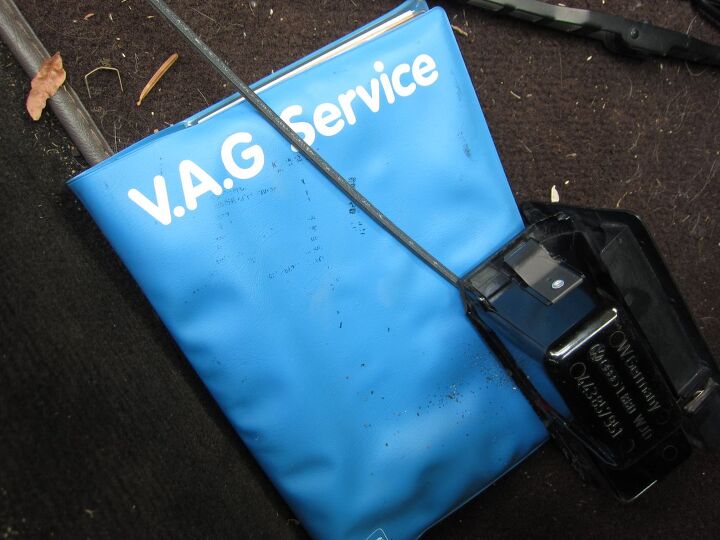Junkyard Find: 1984 Audi 5000 S, With Voodoo Incantantion To Ward Off Unintended Acceleration

The Audi “Unintended Acceleration” debacle of 1986, which whacked American Audi sales by about 75% within a few years, makes the 1982-86 Audi 5000 an historically significant Junkyard Find. The 60 Minutes piece about the 5000’s allegedly malevolent behavior turned the car’s image from masterpiece of aerodynamic science to bloody-clawed multiple murderer, with predictable effects on resale value for existing cars. This means that the 5000 of the Unintended Acceleration era that managed to stay on the good side of The Crusher until 2012 is a survivor of astonishing tenacity.
Plenty of cars had smooth lines like this by the early 1990s, so the ’84 5000 doesn’t really stand out from the crowd these days. Back in the early 1980s, however, this car looked double-take-inducing futuristic.
Everybody has flush glass now, but noisy and drag-inducing inset windows were the norm in the early 1980s. Here’s the car that introduced the flush-glass idea to the marketplace.
So, yeah, this car got a bum rap thanks to panic-mongering journalism. Ford managed to emerge comparatively unscathed from the infamous “Park-To-Reverse” controversy of a few years earlier, even though thousands of 1966-80 Fords really did suffer from a dangerous mechanical flaw.
Not that the 5000 was without its real-life weaknesses, of course; high complexity levels and glitchy electrical components kept cost-of-ownership fairly high for these things.
Note the recall-mandated decal applied to the shifter console. It’s too bad that Audi didn’t add a dash decal identifying the difference between the throttle and brake pedals.
I was impressed by how clean this car looked. Here’s why: 62,837 miles on the clock. Original owner who only drove to church on Sundays?

Murilee Martin is the pen name of Phil Greden, a writer who has lived in Minnesota, California, Georgia and (now) Colorado. He has toiled at copywriting, technical writing, junkmail writing, fiction writing and now automotive writing. He has owned many terrible vehicles and some good ones. He spends a great deal of time in self-service junkyards. These days, he writes for publications including Autoweek, Autoblog, Hagerty, The Truth About Cars and Capital One.
More by Murilee Martin
Latest Car Reviews
Read moreLatest Product Reviews
Read moreRecent Comments
- Theflyersfan The laundry list of things done to this car is huge - check out the link. Yes, those are Lotus Elise seats that were installed. Not sure there's much that hasn't been touched on this car. I don't think this owner is going to try to cash out each penny of the mods put into this car. There looks to be some really good stuff installed under the hood. But this is a hard pass from me. While this isn't as tacky as the "let's throw scissor doors on a bedazzled pink RSX" gaudy, this isn't the most tasteful set of exterior changes either. But for someone with the cash and wants a weekend racer that will be a riot to drive, $20,000 might be about right.
- ToolGuy "tire kickers and low-ballers will be ignored" • Then we are even.
- Slavuta Boeing is crying
- MrIcky I'm reading this fluff piece, and I read some of the other press releases the other day. Although there are a few things that appear that toyota was using harder tests than the government recommends (like a heavier than required rear impact sled), some were more clearly an issue. Some examples I recall:*Timers were used instead of impact sensors on crash testing and this impact data was used as proof of the airbag system working.*Sensor readings were chosen from the incorrect sensor in a way that appears to show lower impact forces on reported metrics.*Engine power tests were pretty clearly just overreported.*Airbag inflation speed timings weren't done using standard testing and it gave a more optimal number than they actually achieved.Although this was Japanese testing, it is likely at least in a couple of cases that this information effects American sold products as it is the same exact setup.
- Bd2 Japan is a godless society without Christianity.























































Comments
Join the conversation
Back in the day, the joke was that bad luck is defined as waiting in line at a toll booth with a Pinto in front and an Audi behind you.
So to all of you who say how unreliable your Audi was, here is ME , i have 1987 Audi 5000 CS Quattro Avant with 242,000 miles on the clock. so far, i've replaced Clutch, and heater core. Car Runs smooth and strong, Turbocharged 5 cylinder , 5 speed, AWD. Body still has no rust, interior is pretty much perfect. and is used as everyday car today - 2012. So before leaving a stupid uneducated comment, consider if it isn't the car's fault, but perhaps you don't know how to own an old car? oh and i owned it since 2003